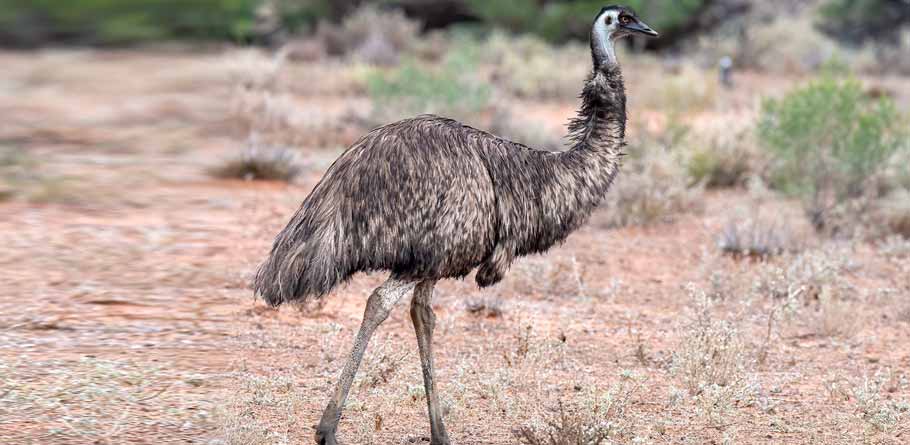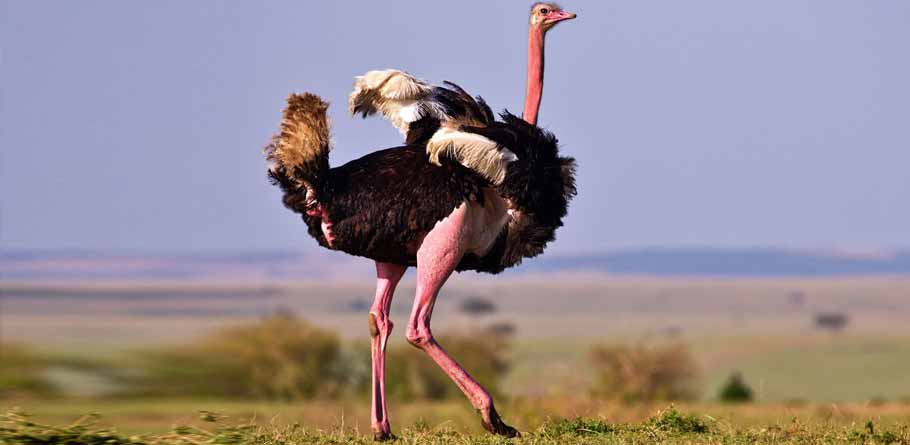Emu vs Ostrich – Differences Between These Giant Birds

Emu vs Ostrich
Welcome to our comparison of two fascinating flightless birds: the Emu vs Ostrich. In this article, we delve into the distinctive features, behaviors, habitats, and other intriguing aspects of these magnificent creatures. Whether you are a bird enthusiast, a researcher, or simply curious about these species, we aim to provide you with an engaging and informative exploration. So, let’s embark on this captivating journey of discovery!
Physical Characteristics
Emu

The Emu (Dromaius novaehollandiae) is the largest bird native to Australia. It stands tall at an average height of 5 to 6.2 feet (1.5 to 1.9 meters) and weighs between 75 and 130 pounds (34 to 59 kilograms). These flightless birds possess a unique appearance, featuring long necks, powerful legs, and small, beady eyes. Emus exhibit predominantly brown plumage, which helps them blend seamlessly into their surroundings, providing them with a natural camouflage advantage.
Ostrich

The Ostrich (Struthio camelus) holds the distinction of being the world’s largest bird. Found in various parts of Africa, this magnificent creature can reach staggering heights of up to 7 to 9 feet (2.1 to 2.7 meters). With a weight ranging from 220 to 350 pounds (100 to 160 kilograms), the Ostrich is truly an impressive sight. It boasts a distinct appearance with a long, graceful neck, large eyes, and powerful, muscular legs. The plumage of the Ostrich is primarily black, complemented by beautiful white feathers adorning its wings and tail.
Habitat and Distribution
Emu
Emus are indigenous to the diverse habitats of Australia. These adaptable birds are found throughout the continent, thriving in a wide range of environments such as forests, woodlands, scrublands, and even arid regions. Emus have the remarkable ability to endure extreme temperatures, enabling them to survive in both hot and cold climates.
Ostrich
The natural habitat of the Ostrich spans the vast grasslands, savannas, and semi-desert regions of Africa. They are particularly prevalent in countries such as South Africa, Namibia, Botswana, and Kenya. Ostriches have adapted to arid environments and can withstand the challenges posed by desert landscapes, displaying remarkable resilience and resourcefulness.
Diet and Feeding Habits
Emu
Emus are omnivorous birds with a varied diet. They primarily feed on vegetation, including fruits, seeds, leaves, flowers, and grass. Additionally, Emus are known to consume insects, small vertebrates, and even the occasional lizard or snake. Their ability to go for long periods without food allows them to survive in environments where food sources may be scarce.
Ostrich
Ostriches are also omnivores but have a predominantly herbivorous diet. Their primary food sources consist of roots, grasses, seeds, and leaves. They are known to ingest pebbles and small stones, which aid in the digestion of their food through the grinding action of the gizzard. Ostriches are opportunistic feeders, adapting their diet based on the availability of resources in their surroundings.
Behavior and Social Structure
Emu
Emus are solitary birds for most of the year, although they come together during the breeding season. The male Emu takes on the responsibility of incubating the eggs and rearing the young chicks, while the female moves on to find another mate. These birds are known for their territorial nature and can become aggressive if they feel threatened. They communicate through various vocalizations, including booming calls and soft grunts.
Ostrich
Ostriches are social birds that typically live in groups called flocks. These flocks can consist of anywhere from 5 to 50 individuals, usually led by a dominant male and female pair. Ostriches exhibit complex courtship rituals, involving elaborate displays such as feather fluffing, hissing, and dancing. The dominant male maintains the territory and guards the nest while the female incubates the eggs. This division of responsibilities ensures the survival and well-being of their offspring.
Adaptations for Speed
Emu
Emus are remarkable runners, capable of reaching speeds up to 30 miles per hour (48 kilometers per hour). Their strong legs and agile feet are well-adapted for swift movement, allowing them to cover great distances in search of food and to evade potential threats. Emus possess three toes on each foot, with one toe bearing a long, sharp claw that aids in defense and territorial battles.
Ostrich
The Ostrich is renowned for its extraordinary speed, making it the fastest land bird. It can achieve speeds of up to 40 to 45 miles per hour (64 to 72 kilometers per hour) during short sprints, and maintain an impressive pace of 30 miles per hour (48 kilometers per hour) over long distances. The Ostrich’s strong, muscular legs and specially adapted tendons enable it to stride with remarkable efficiency, effortlessly covering vast expanses of its native habitat.
Emu vs Ostrich – Comparison Table
Below is a comparison table highlighting some key differences and similarities between Emus and Ostriches:
| Feature | Emu | Ostrich |
|---|---|---|
| Size | 5 to 6.2 feet (1.5 to 1.9 meters) | 7 to 9 feet (2.1 to 2.7 meters) |
| Weight | 75 to 130 pounds (34 to 59 kilograms) | 220 to 350 pounds (100 to 160 kilograms) |
| Habitat | Australia | Africa |
| Diet | Omnivorous | Herbivorous |
| Social Structure | Solitary | Flocks |
| Running Speed | Up to 30 mph (48 km/h) | Up to 45 mph (72 km/h) |
Conclusion
In conclusion, the Emu and the Ostrich are both extraordinary creatures with their own distinct characteristics and adaptations. While the Emu is native to Australia and the Ostrich roams the grasslands of Africa, both species have evolved to survive and thrive in their respective habitats. From their physical attributes to their feeding habits and social behaviors, these flightless birds provide us with a glimpse into the marvels of the natural world.
FAQs: Emu vs Ostrich
Q: What are the main differences between Emus and Ostriches? A: Emus and Ostriches differ in several aspects. Emus are smaller, standing at an average height of 5 to 6.2 feet (1.5 to 1.9 meters), while Ostriches can reach heights of 7 to 9 feet (2.1 to 2.7 meters). Their habitats also vary, with Emus found in Australia and Ostriches in various parts of Africa. Additionally, their social behaviors, diets, and adaptations differ.
Q: Can Emus and Ostriches fly? A: No, neither Emus nor Ostriches can fly. They are both flightless birds, known for their strong legs and running abilities. While they cannot achieve sustained flight, their unique adaptations allow them to move swiftly on the ground.
Q: Which bird is faster, Emu or Ostrich? A: Ostriches are faster than Emus. Ostriches hold the title for being the fastest land bird, reaching speeds of up to 40 to 45 miles per hour (64 to 72 kilometers per hour) during short sprints. Emus, while still swift runners, can run at speeds of up to 30 miles per hour (48 kilometers per hour).
Q: What do Emus and Ostriches eat? A: Emus and Ostriches have different diets. Emus are omnivorous, feeding on a variety of vegetation such as fruits, seeds, leaves, grass, as well as insects and small vertebrates. Ostriches, on the other hand, are primarily herbivorous, consuming roots, grasses, seeds, and leaves.
Q: How long do Emus and Ostriches live? A: Emus typically have a lifespan of about 10 to 20 years in the wild, but some individuals can live up to 30 years or more. In captivity, Emus can live even longer, with some reaching 40 years or more. Ostriches, on the other hand, have a longer lifespan, with wild Ostriches living around 30 to 40 years. In captivity, they have the potential to live even longer, with some reaching 50 years or more.
Searches: Emu vs Ostrich, Ostrich vs Emu, Emu vs Ostrich Guide, Emu vs Ostrich Habitats, Emu vs Ostrich running, Emu vs Ostrich Fight, Emu vs Ostrich Egg, Emu vs Ostrich size, Emu vs Ostrich live, Emu vs Ostrich faster, Emu vs Ostrich Running speed, Emu vs ostrich Weight.
